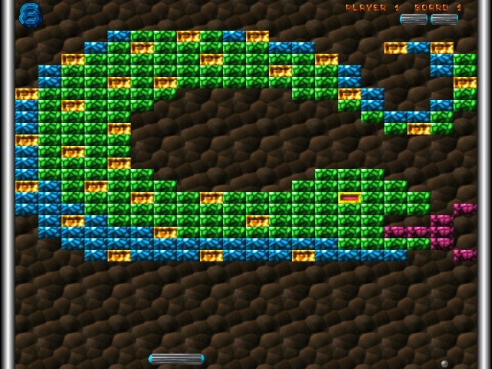

Ball speed increases at specific intervals: after four hits, after twelve hits, and after making contact with the orange and red rows. The paddle shrinks to one-half its size after the ball has broken through the red row and hit the upper wall. Yellow bricks earn one point each, green bricks earn three points, orange bricks earn five points and the top-level red bricks score seven points each. The player has three turns to try to clear two screens of bricks. If the player's paddle misses the ball's rebound, they will lose a turn. Using a single ball, the player must knock down as many bricks as possible by using the walls and/or the paddle below to hit the ball against the bricks and eliminate them. The color order from the bottom up is yellow, green, orange and red. In Japan, the genre is known as block kuzushi ("block breaker") games.īreakout begins with eight rows of bricks, with each two rows a different kinds of color. In 1986 the Breakout concept found new legs with Taito's Arkanoid, which itself spawned dozens of imitators. Super Breakout introduced multiple balls in play at once, which became a common feature in the genre. An official sequel was released in 1978, Super Breakout, which eventually became the pack-in game for the Atari 5200 console in 1982. It was the inspiration for aspects of the Apple II computer and Taito's Space Invaders (1978). While the concept was predated by Ramtek's Clean Sweep (1974), Breakout spawned an entire genre of clones. The 1978 Atari VCS port uses color graphics instead of a monochrome screen with colored overlay. Breakout was a worldwide commercial success, among the top five highest-grossing arcade video games of 1976 in both the United States and Japan and then among the top three highest-grossing arcade video games of 1977 in the US and Japan. The arcade game was released in Japan by Namco.

In Breakout, a layer of bricks lines the top third of the screen and the goal is to destroy them all by repeatedly bouncing a ball off a paddle into them. It was designed by Steve Wozniak, based on conceptualization from Nolan Bushnell and Steve Bristow who were influenced by the seminal 1972 Atari arcade game Pong. Users of DX-Ball gave it a rating of 4 out of 5 stars.Breakout is an arcade video game developed and published by Atari, Inc.

ĭX-Ball runs on the following operating systems: Windows. It was initially added to our database on. The latest version of DX-Ball is currently unknown. It was checked for updates 31 times by the users of our client application UpdateStar during the last month.
Dx ball free download chip software#
OverviewĭX-Ball is a Shareware software in the category Games & Entertainment developed by DX-Ball. If this occurs, all unbreakable blocks will eventually replaced with the breakable ones after a minute or so of the ball being stuck in a bouncing pattern. In certain levels, the layout of unbreakable blocks may allow the ball to become stuck in an infinite loop without touching the paddle. Clearing all the blocks results in completing the level and going to the next. Player controls a paddle at the bottom and deflects a single ball, hitting different colored blocks on the top of the screen without having the ball fall below the screen.

DX-Ball is a brick-breaking game for the PC.


 0 kommentar(er)
0 kommentar(er)
